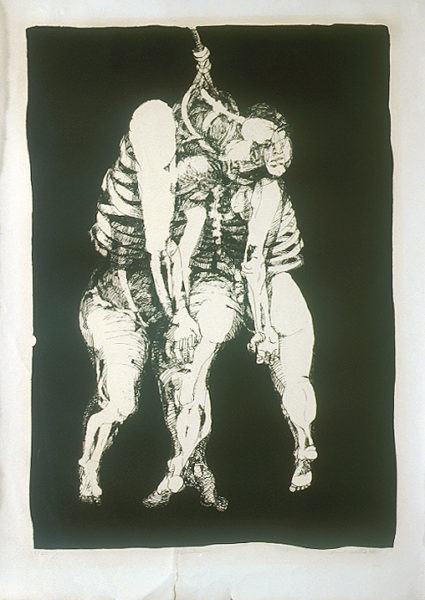Selected Prints (1960–1972): Woman and Bicycle, Execution, Horse and Rider
Introduction The global art scene in the post-World War II era is filled with new ideas and new forms. An influential trend is abstract expressionism developed by American painters such as Jackson Pollock and Willem de Kooning in the 1940s and 1950s. Represented by random paint strokes and splashes created by Pollock, the movement advocates an anti-figurative aesthetic and emphasizes intuitive motions involved in ways of creation. In the postwar era, the art world witnessed the merging of cultural elements and traditional art media. Some American and European artists absorbed elements of traditional and contemporary practices and created unique styles that combined representational and abstract approaches.
The three prints by Nathan Oliveira, Connor Everts, and Marino Marini discussed in this three-part series of essays were created between the years of 1960 and 1972. The works show the artists’ shared interest in combining realism and abstraction. All use biomorphic forms to convey a sense of angst. This recurring motif of bodily distortion is often associated with postwar trauma.
The artists discussed here are active in multifaceted practices including painting and sculpting, yet printmaking has always been an important medium for all of them. On “The Education of the Artist and One Print’s Progress” (1979), Connor Everts said, “One of the marvelous qualities of printmaking is the persistence of memory…. Like a dream, the print keeps taking us back to the same crossroad for yet another chance…. Print is the art of opportunity” (qtd. in Ruby 5).
In this section of the series, we look at the work of Connor Everts.
Connor Everts: Execution

Connor Everts, American, 1926–2016, Execution, 1960, Print, 35 11/16 in. x 24 9/16 in., Scripps College, Claremont, CA
In the lithograph, Execution, the human form evokes both death and a sense of intimacy. Against a black background, two skeletal bodies hanging from a noose are entangled. The hands of the figures clutch together; the heads droop from elongated necks and rest on each other’s body. The exposed rib bones cast shadows on pale, swollen limbs.
The print was made by Los Angeles artist, Connor Everts, whose figurative drawings often create an uncanny atmosphere. Born in Bellingham, Washington, Everts moved to Los Angeles with his family and served in the U.S. Coast Guard during World War II. Later, he traveled extensively throughout Europe and South America as an art student.
Although Everts enjoyed early fame as an award-winning artist, he became constantly involved in controversies of the “obscenity” in his artwork, whether in terms of stylistic choices or subject matter. In 1964, the Los Angeles police shut down an exhibition of his work at the Zora Gallery and arrested him (“Conner Everts Biography”). This was one of the most notorious events that Everts was involved in.
Decades later, people were able to appreciate the sophistication in the unsettling scenes Everts depicts. The fragmented bodies were reflective of the artist’s inner struggles and the turmoil of the era. The disturbing effect in Everts’ work is manifested in bodily distortion, through which he questions mechanisms of human society and concepts of life and existence. The motifs he uses are conversations with other L.A contemporaries: the ripped organic shapes evoke the work by Rico Lebrun, and the skeletons suggest Howard Warshaw’s figurative drawings about death.
In postwar artistic expression, the distortion or fragmentation of human bodies is among the most commonly used of visual languages, referring to human atrocity. In Execution, the body is visually “dissected.” The bone structure of the upper torsos is clearly shown, and the positioning of the figures is indicative of a slaughterhouse. The deformed body parts, such as the elongated necks and protruding foreheads, further eliminate human characterizations and blur the boundaries between living figures and lifeless forms.
Execution strangely suggests camaraderie. The noose acts as a contact point between the two figures that share both pain and intimacy. Underneath grotesque elements, work by Everts draws attention to spiritual connection and shared trauma that transcend bodily forms.
Written by Chenlu (Cindy) Zhu (SC ’19) Wilson Summer Intern 2019
Works Cited
“Connor Everts Biography: Annex Galleries Fine Prints.” The Annex Galleries, www.annexgalleries.com/artists/biography/666/Everts/Connor.
Cummings, Paul. “Interview: Nathan Oliveira Talks with Paul Cummings.” Drawing, 1988, pp. 30–34. Cutler, Ellen B. “Archetype and Allegory: Marino Marini’s Horses and Riders.” Sculpture Review, vol. 55, no. 2, June 2006, pp. 20–25.
Hodin, Joseph Paul. “Marino Marini: Man and Horse, Man and Woman; with French, Italian and German Summaries.” Studio International, vol. 167, Mar. 1964, pp. 94–99.
Hunter, Sam. Marino Marini–the Sculpture. Abrams, 1993.
Martini, Chris. “Nathan Oliveira: Cruising in the Fast Lane.” Studio International, vol. 197, no. 1007, Dec. 1984, pp. 62–63.
Ruby, Kalen. “Variations on a Theme.” Artweek, vol. 15, Dec. 1984, pp. 5–5.
Tooker, Dan. “Nathan Oliveira, Interviewed by Dan Tooker.” Art International, vol. 17, Dec. 1973, pp. 56–57.
Image on slider: Marino Marini, Italian, 1901-1980, Horse and Rider, 1972, Print, 14 3/8 in. x 19 3/4 in., Scripps College, Claremont, CA

